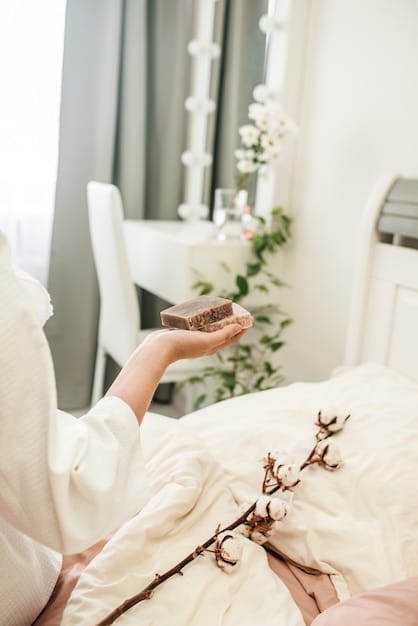Declutter Your Mind, Declutter Your Home: 7-Day Zen Guide

Declutter Your Mind, Declutter Your Home: A Zen Approach to Simplifying Your Life in 7 Days outlines a practical plan to remove physical and mental clutter through mindfulness, organization, and intentional living, fostering a calmer, more focused existence.
Feeling overwhelmed by the chaos in your home and mind? Declutter Your Mind, Declutter Your Home: A Zen Approach to Simplifying Your Life in 7 Days can guide you towards a more peaceful and intentional way of living by removing unnecessary clutter and fostering a sense of calm.
Understanding Zen and Decluttering
Zen principles emphasize simplicity, mindfulness, and living in the present moment. Applying these principles to decluttering can transform it from a daunting chore into a mindful practice, reducing stress and promoting mental clarity.
The Essence of Zen
At its core, Zen is about finding inner peace through meditation and awareness. It teaches us to appreciate the present moment and to let go of attachments that cause suffering. This philosophy can be particularly helpful when dealing with the **clutter** in our lives, both physical and mental.
Decluttering as a Zen Practice
When approached mindfully, decluttering becomes an exercise in letting go. It’s about asking ourselves what truly adds value to our lives and releasing what no longer serves us. This process mirrors the Zen practice of non-attachment, freeing us from the burden of possessions and the mental baggage they carry.
- Mindful Decision-Making: Evaluating each item’s purpose and sentimental value.
- Non-Attachment: Letting go of items you no longer need or love.
- Present Moment Awareness: Focusing on the task at hand without getting overwhelmed by the entire project.
By viewing decluttering through a Zen lens, we transform it from a chore into a practice that nurtures our well-being and brings us closer to a state of inner peace.
Day 1: Mindful Assessment of Your Space
Begin your 7-day journey by taking a mindful assessment of your home. This involves observing your surroundings without judgment, identifying areas of clutter, and understanding how they affect your peace of mind.
Observe Without Judgment
Walk through each room in your home, paying attention to how you feel in each space. Notice the areas where clutter accumulates and how it impacts your mood. Avoid criticizing yourself or your habits; simply observe with curiosity.
Identify Clutter Hotspots
Clutter often concentrates in specific areas. Common hotspots include countertops, closets, and corners. Note these areas and consider why clutter tends to gather there.

Reflect on Your Emotional Response
Consider how the clutter makes you feel. Does it cause stress, anxiety, or a sense of being overwhelmed? Understanding your emotional response is crucial for motivating change.
This initial assessment sets the stage for a more intentional and effective decluttering process. It allows you to approach each item with awareness and purpose, making the journey both productive and mindful.
Day 2: Creating a Vision for a Clutter-Free Life
Day two is about envisioning your ideal, clutter-free life. Visualizing the positive impact of a tidy home and a clear mind can provide the motivation and direction needed to stay committed to the decluttering process.
Visualize Your Ideal Space
Imagine what your home would look and feel like without the clutter. Picture each room as a calm, organized sanctuary. Consider the colors, textures, and arrangement of furniture that would make you feel most at peace.
Define Your Goals
Clearly define what you hope to achieve through decluttering. Do you want to reduce stress, improve focus, or create a more inviting atmosphere? Having specific goals will help you stay on track and measure your progress.
- Reduce Stress: A clutter-free home promotes a sense of calm and order.
- Improve Focus: A clear space supports a clear mind, enhancing productivity.
- Create a More Inviting Atmosphere: A tidy home is more welcoming to guests and family members.
Write Down Your Intentions
Putting your vision and goals in writing makes them more tangible and reinforces your commitment. Write a brief paragraph describing your ideal clutter-free life and the benefits it will bring. Refer back to this statement when you feel overwhelmed or discouraged.
By creating a clear vision of your desired outcome, you set the stage for a successful and transformative decluttering journey. This vision will guide your decisions and keep you motivated throughout the process.
Day 3: Tackle the Easy Wins
On day three, focus on the “easy wins” – those areas of your home where you can quickly and easily remove clutter without much emotional attachment. This approach builds momentum and provides a sense of accomplishment.
Identify Low-Hanging Fruit
Start with areas that are less sentimental or emotionally charged, such as junk drawers, expired food in the pantry, or old magazines. These items are generally easier to discard without much angst.
Implement the 20-Minute Rule
Set a timer for 20 minutes and focus on decluttering one small area. When the timer goes off, take a break. Repeating this process in short bursts can make the task less daunting and more manageable.
The Four-Box Method
Use four boxes labeled “Keep,” “Donate,” “Recycle,” and “Trash.” As you go through each item, place it in the appropriate box. This method helps you make quick decisions and keeps the process organized.
By focusing on easy wins, you create a positive feedback loop and build the confidence needed to tackle more challenging areas later in the week. This approach makes the decluttering process feel less overwhelming and more achievable.
Day 4: Dealing with Sentimental Items
Day four is often the most challenging, as it involves confronting sentimental items. These items hold emotional significance, making it difficult to decide whether to keep or let go.
Acknowledge Your Feelings
Allow yourself to feel the emotions that arise when handling sentimental items. Acknowledge the memories and associations attached to each object. This validation is crucial for making mindful decisions.
Ask the Right Questions
When considering whether to keep a sentimental item, ask yourself these questions:
- Does this item bring me joy?
- Does it align with my vision for a clutter-free life?
- Will I use or display this item regularly?
Create a Memory Box
For items you can’t bear to part with, consider creating a memory box. This allows you to keep a small collection of cherished items without overwhelming your space.

Document and Let Go
If you’re struggling to let go of an item, take a photograph of it. Documenting the memory can help you feel less attached to the physical object.
Dealing with sentimental items requires patience, compassion, and a willingness to honor your emotions. By approaching these items with mindfulness and intention, you can make thoughtful decisions that align with your vision for a clutter-free life.
Day 5: Organizing and Creating Systems
Decluttering is only half the battle. Day five is about organizing what you’ve decided to keep and creating systems to prevent future clutter from accumulating.
Categorize and Group Items
Sort your belongings into categories, such as clothing, books, and kitchen supplies. Group similar items together to make them easier to find and use.
Maximize Vertical Space
Utilize shelves, drawers, and wall-mounted organizers to maximize vertical space. This creates more storage and keeps items off the floor and countertops.
The One In, One Out Rule
Implement the “one in, one out” rule. For every new item you bring into your home, get rid of a similar item. This helps prevent clutter from building up over time.
Establish Daily Habits
Make tidying up a part of your daily routine. Spend a few minutes each day putting things back in their place. Small, consistent efforts can prevent clutter from becoming overwhelming.
Organization is not about achieving perfection, but about creating functional systems that support your lifestyle. By establishing these systems, you can maintain a clutter-free home with minimal effort.
Day 6: Digital Decluttering and Mental Clarity
Clutter isn’t limited to physical possessions; it also exists in the digital realm. Day six is dedicated to decluttering your digital devices and promoting mental clarity.
Unsubscribe from Unnecessary Emails
Go through your email inbox and unsubscribe from newsletters and promotional emails that you no longer find valuable. This reduces digital clutter and makes it easier to find important messages.
Organize Your Desktop and Files
Clean up your computer desktop by deleting unnecessary files and organizing the remaining ones into folders. A tidy desktop promotes a sense of calm and focus.
Limit Social Media Consumption
Set boundaries for your social media use. Limit the amount of time you spend scrolling through feeds and unfollow accounts that drain your energy or make you feel inadequate.
- Set a Timer: Allocate a specific amount of time for social media each day.
- Unfollow Draining Accounts: Remove accounts that trigger negative emotions.
- Engage Mindfully: Be intentional about the content you consume and create.
Practice Mindfulness Techniques
Incorporate mindfulness techniques, such as meditation or deep breathing, into your daily routine. These practices help clear your mind and reduce stress.
Digital clutter can be just as overwhelming as physical clutter. By decluttering your digital devices and practicing mindfulness techniques, you can promote mental clarity and improve your overall well-being.
Day 7: Sustaining a Clutter-Free Lifestyle
The final day is about creating sustainable habits that will help you maintain a clutter-free lifestyle long after the 7-day challenge. This involves ongoing mindfulness, conscious consumption, and regular maintenance.
Practice Daily Mindfulness
Continue to incorporate mindfulness into your daily routine. Pay attention to your thoughts, feelings, and surroundings. This heightened awareness will help you make more intentional decisions about what you bring into your life.
Shop Intentionally
Before making a purchase, ask yourself if you truly need the item or if it’s just an impulse buy. Consider the environmental impact of your purchases and opt for sustainable, high-quality products.
Schedule Regular Decluttering Sessions
Set aside time each month or season for a quick decluttering session. This prevents clutter from accumulating and helps you stay on top of your organizational systems.
Reflect and Adjust
Regularly reflect on your decluttering habits and make adjustments as needed. As your needs and priorities change, your organizational systems should evolve to reflect those changes.
Sustaining a clutter-free lifestyle is not about perfection, but about cultivating mindful habits and creating systems that support your well-being. By continuing to practice these principles, you can enjoy the benefits of a clutter-free home and a clear mind for years to come.
| Key Point | Brief Description |
|---|---|
| 🧘 Mindfulness | Emphasizes present moment awareness, reducing stress. |
| 🧹 Decluttering | Removes physical and digital clutter, promoting clarity. |
| 📦 Organization | Creates functional systems for easy access and storage. |
| 🔄 Sustainability | Promotes conscious consumption and regular maintenance. |
Frequently Asked Questions
Zen decluttering is a mindful approach to removing clutter, emphasizing simplicity and present moment awareness. It transforms decluttering from a chore into a practice that enhances well-being.
Begin by assessing your space without judgment, identifying clutter hotspots, and reflecting on your emotional response to the clutter. This sets the stage for a more intentional decluttering process.
Easy wins involve decluttering areas that are less sentimental, such as junk drawers or expired items. This builds momentum and provides a sense of accomplishment early on.
Acknowledge your feelings, ask if the item brings joy, and consider creating a memory box for cherished items you can’t part with. Documenting items can also help you let go.
Practice daily mindfulness, shop intentionally, schedule regular decluttering sessions, and regularly reflect on your decluttering habits to sustain a clutter-free lifestyle.
Conclusion
Embarking on a 7-day Zen approach to decluttering your mind and home offers a transformative journey towards simplicity and intentional living. By integrating mindfulness, organization, and conscious consumption, you can create a more peaceful, focused, and fulfilling life.





